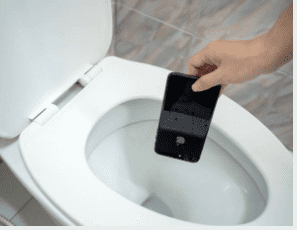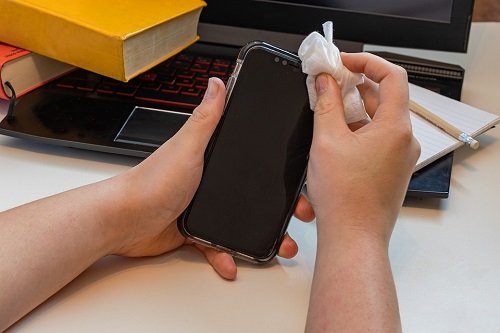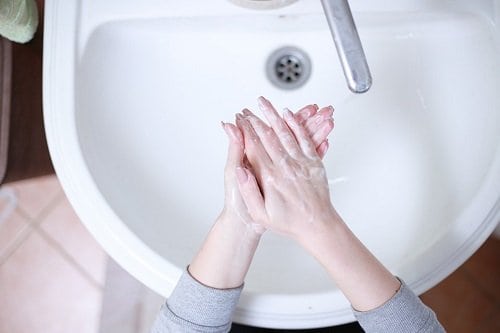When you drop something in the toilet, it is not unusual to wonder whether to leave it or pick it up. If the item has monetary or sentimental value, you will probably pick it up. You might also decide to pick up any non-flushable item and throw it away to avoid clogging the toilet. Since such accidents happen from time to time, you’ll want to learn a few tricks on how to disinfect something that fell in the toilet to avoid spreading the germs.
How to Retrieve Something That Fell in the Toilet
When you inadvertently drop something in the toilet bowl, you need to retrieve it quickly. However, you should recover the item using techniques that minimize your exposure to germs. Some of the tools you require on your salvage mission include rubber gloves and a wire.
Rubber gloves protect you from direct contact with bacteria and viruses. If you do not have rubber gloves in your vicinity, you can consider alternatives such as plastic bags. Remember to retrieve the items quickly to minimize water damage.
When retrieving the dropped item, grip it firmly to avoid releasing it back into the water. Dropping the item for the second time could render it irretrievable. If it is an electronic device such as a smartphone, taking too much time to retrieve it could do irreversible damage.

Everyday Items You Could Retrieve From the Toilet
You can decontaminate most items and materials that fall in the toilet bowl water. However, some items require special procedures to avoid damaging them. Here is a list of objects you can sanitize after falling in the toilet.
- Cellphones
- Leather
- Porcelain
- Plastic
- Metal
- Wood
- Textiles
- Glass
What to Do After Dropping Your Smartphone in Toilet Bowl Water
Dropping your smartphone in the toilet bowl can be an agonizing experience since the device bears monetary and sentimental value. However, you will be surprised to know that inadvertently dipping your smartphone in the toilet bowl water is not the end of the road for it. Here is a multistep process you can follow to make it usable again.
Step One: Clean Your Smartphone with Tap Water
After retrieving your smartphone from the toilet bowl, you should begin by cleaning it with tap water. This process removes any residue urine or fecal material on the smartphone surface. Remember to expedite the process to ensure that water does penetrate critical internal parts.
Step Two: Drying
Wipe the smartphone with a dry cloth and place it in absorbent material for 24 hours. Effective materials may include sodium poly-acrylate and ordinary rice.
Step Three: Disinfection
Disinfect the phone by rubbing a cloth dipped in alcohol on the smartphone. If your smartphone does not boot after completing this step, consider taking it to a phone technician.

How to Disinfect Something That Fell in the Toilet
Retrieving a valuable item from the toilet bowl is the easy part. The big challenge lies in disinfecting the object to prepare it for everyday use. You need to note that toilet water contains wide-ranging disease-causing pathogens.
You can use different methods to disinfect items that fall in the toilet bowl water. The most suitable technique is contingent upon the composite materials of the item in question. Here is a list of methods you can apply to sanitize something retrieved from the toilet bowl.
Method One: Using Alcohol
Alcohol is very effective in killing disease-causing pathogens on various surfaces. You need to rub it on the contaminated surface with a cotton cloth. The alcohol concentration in your disinfectant of choice should range from 60% to 90%.
Alcohol-based disinfectants can kill fungi, viruses, and bacteria. However, they cannot exterminate bacteria spores. You can use alcohol-based disinfectants to disinfect metallic items such as keys and smartphones.
Method Two: Hydrogen Peroxide
Hydrogen peroxide is the answer if you need a substance with greater disinfection capabilities than alcohol. Hydrogen peroxide kills bacteria, viruses, bacterial spores, and fungi quickly. Notably, the hydrogen peroxide concentration in the disinfection agent should be 7.5%.
Overall, hydrogen peroxide is ideal for disinfecting items made of plastic material. However, the chemical is not suitable for decontaminating metallic items. Hydrogen peroxide ordinarily triggers a chemical reaction upon contact with metal.
You should dip the item you intend to sterilize in a hydrogen peroxide-based disinfectant for approximately 6 hours, but the actual disinfection takes just 30 minutes. Remember that the hydrogen peroxide concentration in the disinfectant should be at least 7.5%.
When working with hydrogen peroxide-based disinfectants, you should handle them with care. Mishandling the chemical can result in significant eye, hair, and skin damage. It is advisable to use protective gear, including rubber gloves.
Method Three: Water and Soap
If you do not have highly effective products such as alcohol, you can resort to temporary measures such as using water and soap. Ideally, you should use warm water instead of hard water. Water and soap can kill certain viruses and clean off urine and fecal residues.
Even if soap and water don’t kill most pathogens, the combination can come in handy in certain instances. You can use soap and water if you do not have protective gloves to handle highly potent chemicals. Additionally, you can use the combination to disinfect glass lenses.
Cleaning glass lenses with certain disinfectants can cause irreparable damage. Soap and water offer a safe and affordable alternative for achieving your desired result. It would be best to use a dry cloth to wipe off lather after cleaning with soap and water.

Method Four: Boiling
Boiling is a highly effective technique for disinfecting something that fell in the toilet. Most protozoa, viruses, and bacteria cannot survive at the boiling point of water. Notably, viruses have greater tolerance to high temperatures than bacteria.
It would be best to keep the item you want to decontaminate in boiling water for an extended period. Most disease-causing pathogens die at 600C within seconds, while others persist until the water temperature hits 800C. Here are the steps you should follow when using the boiling technique.
- Fill a large enough pot with water and place it on a stove.
- Lower the item into the pot with tongs to avoid getting burned. Ensure that the item can withstand high temperatures and leave it for roughly 20 minutes.
- Retrieve the item with a pair of tongs and leave it to dry.
The boiling technique is not without its fair share of disadvantages. You might find it gross to boil an item that fell in the toilet in a household pot. Additionally, the method is not ideal for items with low heat tolerance.
Method Five: Ironing
Ironing uses the same principle as the boiling technique. Notably, ironing relies on high temperatures to kill disease-causing pathogens. The method is suitable for items made of cotton and silk.
It would be best to move an iron box back and forth over your germ-laden linen to disinfect it. However, placing a hot iron box on one spot for too long can damage your cloth irreversibly. Ironing kills all bacteria, fungi, bacterial spores, and protozoa on linen because a hot iron box has a temperature between 1800C and 2200C. It is worth noting that most pathogens cannot survive in temperatures exceeding 800C.
Unfortunately, ironing can be disadvantageous because it is not suitable for disinfecting most items that fall in the toilet. For instance, the ironing technique ordinarily deforms and melts plastic products. The method is also inappropriate for disinfecting irregularly shaped items retrieved from the commode.
If your personal care item falls in toilet bowl water, you should consider disposing of it altogether. Ironing often exposes personal care items such as menstrual cups to irreparable damage. In such instances, you should consider purchasing another one.
Method Six: Bleaching
Bleaching is one of the most effective techniques for disinfecting items that fall in the toilet bowl water. Most bleach products contain chlorine compounds. Additionally, effective household bleach products contain sodium hypochlorite concentrations of between 5% and 8%.
To obtain a solution with adequate antimicrobial activity, you should mix one part bleach with ten parts water. A higher bleach concentration effectively kills viruses, fungi, bacterial spores, bacteria, and protozoa. It is best to use a lower concentration to minimize the risk of injury.
You can use bleach to disinfect items made of porcelain, plastic, and glass. Using it on metal objects such as keys can trigger chemical reactions that cause irreparable damage. Notably, bleach is a readily available toilet disinfection product.
You should handle bleach products to avoid physical injury. It is advisable to wear protective gloves to mix bleach with water and submerge and retrieve your contaminated item from the water. Always read the instructions written on different bleach products to minimize potential risks.
Bottom Line
Dropping something in toilet bowl water is a distressful and nasty experience. However, it is possible to restore the item to its normal state by retrieving and disinfecting it. If you drop your smartphone, you must recover it as quickly as possible to increase the chances of restoration. Ultimately, the disinfection technique you choose for disinfecting an item that fell in the toilet depends on its composite materials.
